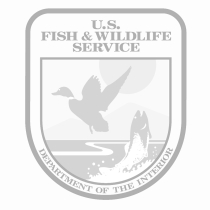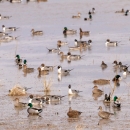States
Alabama, Alaska, Arizona, Arkansas, California, Colorado, Connecticut, Delaware, Florida, Georgia, Hawaii, Idaho, Illinois, Indiana, Iowa, Kansas, Kentucky, Louisiana, Maine, Maryland, Massachusetts, Michigan, Minnesota, Mississippi, Missouri, Montana, Nebraska, Nevada, New Hampshire, New Jersey, New Mexico, New York, North Carolina, North Dakota, Ohio, Oklahoma, Oregon, Pennsylvania, Rhode Island, South Carolina, South Dakota, Tennessee, Texas, Utah, Vermont, Virginia, Washington, West Virginia, Wisconsin, WyomingThe annual process of setting duck hunting regulations in the United States is based on a system of resource monitoring, data analyses, and rule making.
Each year, monitoring activities such as aerial surveys and hunter questionnaires provide information on harvest levels, population size, and habitat conditions. Data collected from this monitoring program are analyzed each year, and proposals for duck-hunting regulations are developed by the Flyway Councils, States, and the U.S. Fish & Wildlife Service (USFWS). After extensive public review, the USFWS announces a regulatory framework within which States can set their hunting seasons.
In 1995, the USFWS adopted the concept of adaptive resource management for regulating duck harvests in the United States. The adaptive approach explicitly recognizes that the consequences of hunting regulations cannot be predicted with certainty, and provides a framework for making objective decisions in the face of that uncertainty. Inherent in the adaptive approach is an awareness that management performance can be maximized only if regulatory effects can be predicted reliably. Thus, adaptive management relies on an iterative cycle of monitoring, assessment, and decision making to clarify the relationships among hunting regulations, harvests, and waterfowl abundance.
In regulating waterfowl harvests, managers face four fundamental sources of uncertainty:
- environmental variation - the temporal and spatial variation in weather conditions and other key features of waterfowl habitat; an example is the annual change in the number of ponds in the Prairie Pothole Region, where water conditions influence duck reproductive success;
- partial controllability - the ability of managers to control harvest only within limits; the harvest resulting from a particular set of hunting regulations cannot be predicted with certainty because of variation in weather conditions, timing of migration, hunter effort, and other factors;
- partial observability - the ability to estimate key population attributes (e.g., population size, reproductive rate, harvest) only within the precision afforded by existing monitoring programs; and
- structural uncertainty - an incomplete understanding of biological processes; a familiar example is the long-standing debate about whether harvest is additive to other sources of mortality or whether populations compensate for hunting losses through reduced natural mortality. Structural uncertainty increases contentiousness in the decision-making process and decreases the extent to which managers can meet long-term conservation goals.
Adaptive Harvest Management (AHM) was developed as a systematic process for dealing objectively with these uncertainties. The key components of AHM include:
- a limited number of regulatory alternatives, which describe Flyway-specific season lengths, bag limits, and framework dates;
- a set of population models describing various hypotheses about the effects of harvest and environmental factors on waterfowl abundance;
- a measure of reliability (probability or "weight") for each population model; and
- a mathematical description of the objective(s) of harvest management (i.e., an "objective function"), by which alternative regulatory strategies can be evaluated.
These components are used in a stochastic optimization procedure to derive a regulatory strategy, which specifies the appropriate regulatory alternative for each possible combination of breeding population size, environmental conditions, and model weights.
The setting of annual hunting regulations then involves an iterative process:
- each year, an optimal regulatory alternative is identified based on resource and environmental conditions, and on current model weights;
- after the regulatory decision is made, model-specific predictions for subsequent breeding population size are determined;
- when monitoring data become available, model weights are increased to the extent that observations of population size agree with predictions, and decreased to the extent that they disagree; and
- the new model weights are used to start another iteration of the process.
By iteratively updating model weights and optimizing regulatory choices, the process should eventually identify which model is most appropriate to describe the dynamics of the managed population. The process is optimal in the sense that it provides the regulatory choice each year necessary to maximize management performance. It is adaptive in the sense that the harvest strategy "evolves" to account for new knowledge generated by a comparison of predicted and observed population sizes.










